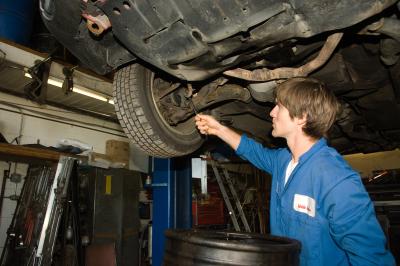
Replacing the rear brake pads or shoes will repair the parking brake system on most Ford cars and light trucks. However, the Ford rear disc brakes used on late-model trucks and SUVs require the replacement of a special set of parking brake shoes located behind and inside the hat area of the rotor. There are some special concerns with this system because the friction surface in the hat are that these shoes work against is not serviceable. If there is damage to the parking brake area of the rotor, replace the rotor as well as the shoes.
Place wheel chocks behind the front wheels, and raise the rear wheels off the ground with the floor jack. Position jack stands under the rear axle, and lower the vehicle onto the jack stands. Remove the rear wheels with the lug wrench, and store the wheels and lug nuts out of the way. Lifting and supporting the vehicle in this way will prevent injury.
Remove the caliper by removing the retaining bolts, and prying the caliper off the rotor. Examine the rotor for damage and replace it when needed. If you are unsure, take the rotor to the local auto parts store, and they will measure it and advise you if a replacement is required. The key area of concern for the rear parking brakes is the inside of the hat area of the rotor. This machined area provides the friction surface that the parking brake shoes grip when they are applied. It is not machinable. Replace the rotor if damage is present.
Remove and replace the parking brake shoes, by removing the return springs that connect the shoes at the top and the bottom of the set. Then remove the hold-down retainers, and the shoes will come right off. Position the shoes on the backing plate and install the retaining clips one at a time. Then stretch the return springs into place.
Adjust the parking brake so that there is a slight drag on the rotor from shoe contact. Do this by turning the star-shaped adjuster located near the bottom of the shoes. Reinstall the rotor and caliper, and tighten the caliper bolts securely.
Reinstall the wheels and lower the vehicle to the ground. Pump the brake pedal until it gets hard to push. Test the parking brake by applying it. Then start the engine and put it into gear. The brake should prevent the vehicle from moving.